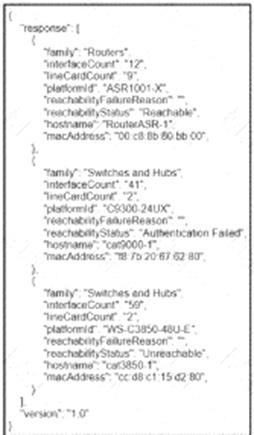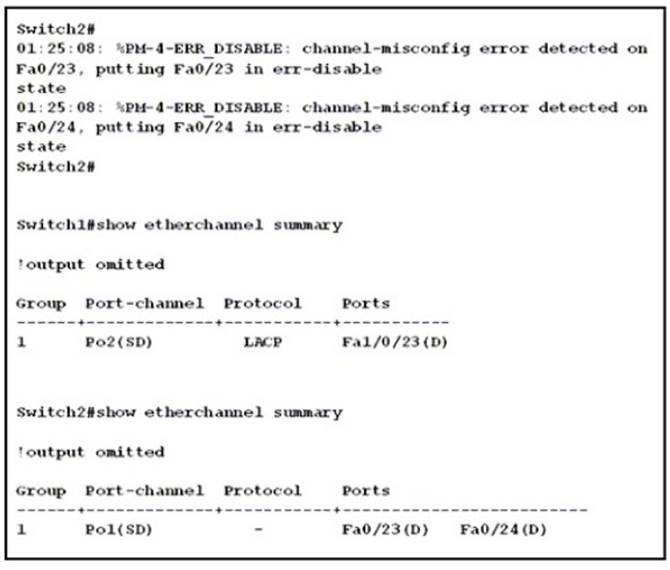- (Topic 4)
What is a benefit of YANG modules?
Correct Answer:
B
- (Topic 1)
Refer to the exhibit.
Which HTTP JSON response does the python code output give?
Correct Answer:
D
- (Topic 1)
Refer to the exhibit. An engineer is configuring an EtherChannel between Switch1 and Switch2 and notices the console message on switch2. Based on the output, which action resolves this issue?
Correct Answer:
C
In this case, we are using your EtherChannel without a negotiation protocol on Switch2. As a result, if the opposite switch is not also configured for EtherChannel operation on the respective ports, there is a danger of a switching loop. The EtherChannel Misconfiguration Guard tries to prevent that loop from occuring by disabling all the ports bundled in the EtherChannel.
- (Topic 2)
How does CEF switching differ from process switching on Cisco devices?
Correct Answer:
B
Cisco Express Forwarding (CEF) switching is a proprietary form of scalable switching intended to tackle the problems associated with demand caching. With CEF switching, the information which is conventionally stored in a route cache is split up over several data structures. The CEF code is able to maintain these data structures in the Gigabit Route Processor (GRP), and also in slave processors such as the line cards in the 12000 routers. The data structures that provide optimized lookup for efficient packet forwarding include:
✑ The Forwarding Information Base (FIB) table - CEF uses a FIB to make IP destination prefix-based switching decisions. The FIB is conceptually similar to a routing table or information base. It maintains a mirror image of the forwarding information contained in the IP routing table. When routing or topology changes occur in the network, the IP routing table is updated, and these changes are reflected in the FIB. The FIB maintains next-hop address information based on the information in the IP routing table.
Because there is a one-to-one correlation between FIB entries and routing table entries, the FIB contains all known routes and eliminates the need for route cache maintenance that is associated with switching paths such as fast switching and optimum switching.
✑ Adjacency table - Nodes in the network are said to be adjacent if they can reach each other with a single hop across a link layer. In addition to the FIB, CEF uses adjacency tables to prepend Layer 2 addressing information. The adjacency table maintains Layer 2 next-hop addresses for all FIB entries.
CEF can be enabled in one of two modes:
✑ Central CEF mode - When CEF mode is enabled, the CEF FIB and adjacency tables reside on the route processor, and the route processor performs the express forwarding. You can use CEF mode when line cards are not available for CEF switching, or when you need to use features not compatible with distributed CEF switching.
✑ Distributed CEF (dCEF) mode - When dCEF is enabled, line cards maintain identical copies of the FIB and adjacency tables. The line cards can perform the express forwarding by themselves, relieving the main processor - Gigabit Route Processor (GRP) - of involvement in the switching operation. This is the only switching method available on the Cisco 12000 Series Router.
dCEF uses an Inter-Process Communication (IPC) mechanism to ensure synchronization of FIBs and adjacency tables on the route processor and line cards.
For more information about CEF switching, see Cisco Express Forwarding (CEF) White Paper.
- (Topic 2)
Which new enhancement was implemented in Wi-Fi 6?
Correct Answer:
D